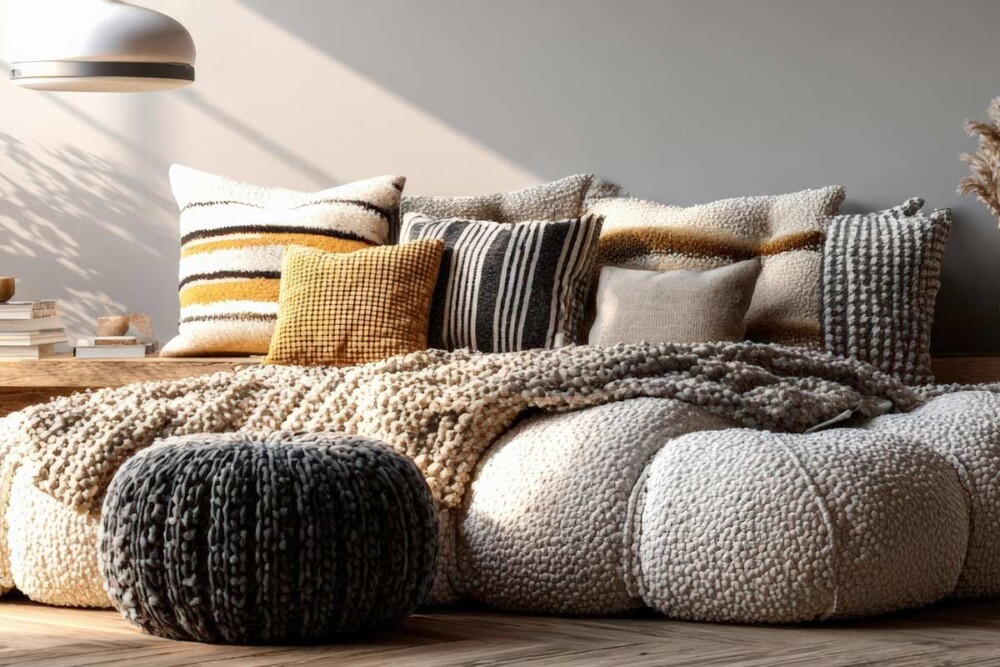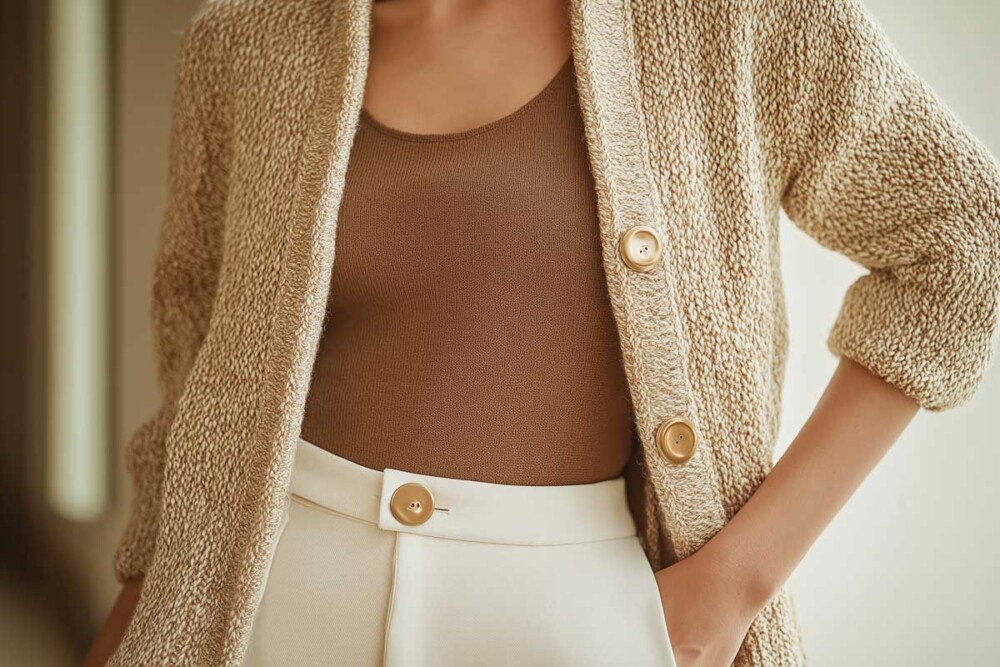Bouclé fabric is an iconic material, appreciated for its three-dimensional texture and the material effect that gives depth to both clothing and furnishing elements. The characteristic surface, composed of small irregular loops, makes each realization visually rich and pleasant to the touch. Manifattura Foderami Cimmino explains what bouclé fabric is, how to recognize it, what its main applications are, and how to work it correctly to achieve professional results.

What is bouclé fabric: definition, origin, and how it is made
Boucle is a fabric recognizable by its ring-like structure that creates a loose, irregular surface. It is used in both fashion and interior design due to its sophisticated appearance and ability to add volume without weighing it down. Understanding how it is produced helps us understand its qualities and why it remains a great classic in the textile industry.
Origin of bouclé fabric and meaning of the term
The term “bouclé” derives from the French boucler, meaning “to curl”. It refers to the small loops present in the weft of the yarn, created through a studied twist. This type of workmanship was introduced into luxury clothing in the ’50s, immediately becoming a symbol of timeless elegance.
How bouclé yarn is produced and what its texture depends on
Bouclé yarn is born from a particular twisting technique that generates small loops. These loops create a soft, uneven tactile effect, with an instantly recognizable aesthetic. Depending on the type of yarn, the result can be very material or lighter, with barely hinted knots.

Boucle fabric characteristics: composition, weight, hand and quality
The characteristics of bouclé depend on several factors: starting fiber, spinning, weight and weft density. Knowing them allows you to choose the most suitable fabric for your project, avoiding errors or short-lived results.
Boucle composition: natural, synthetic or mixed fibres
Boucle can be made of wool, cotton, polyester or mixed. Wool provides warmth and a more traditional texture, while polyester offers strength, ease of maintenance, and generally lower costs. The mixed variants combine both advantages, making it a versatile fabric suitable for different applications.
Hand, thickness and weight of boucle fabric
The hand of the boucle is generally soft, voluminous and slightly grainy. The
Advantages and limitations of bouclé: what to know before choosing
Among the advantages, aesthetics, softness, warmth and refined visual rendering stand out. The main limitation is the tendency to fray, a characteristic that requires foresight in the cutting and sewing phases. Maintenance may also require care, especially if the fabric contains natural fibers.

Uses of boucle fabric: fashion, interior design and creative projects
Boucle is an extremely versatile fabric. Its distinctive structure lends itself to a wide range of applications, from fashion design to furniture. Knowing the main uses helps you quickly identify the type that best suits your goal.
Boucle fabric for clothing: jackets, suits, coats and accessories
For decades, bouclé has been a protagonist among clothing fabrics thanks to its ability to bring elegance and structure to garments. It is ideal for jackets, suits, skirts, coats, winter dresses and even bags. Its irregular surface adds movement and character even to simple autumn fabric patterns, a feature that makes it highly prized in contemporary collections.
Boucle fabric for furniture: sofas, armchairs, ottomans and cushions
In the world of interior design, bouclé is synonymous with warmth and materiality. Bouclé furnishing fabrics tend to have a tighter, more durable weave, perfect for covering upholstery subject to daily wear and tear. They are used for sofas, armchairs, upholstered chairs, poufs and decorative accessories such as cushions or textile panels.
Tessuto Bouclé Emily
Tessuto Bouclé Emily is designed for those who want to bring a combination of comfort, warmth and style to the interior. Its soft and full-bodied surface, characterized by the typical slightly choppy effect, gives depth and movement, transforming every piece of furniture into a refined detail. Used on sofas, armchairs, cushions and curtains, it adds an immediate feeling of welcome, making environments more sophisticated and enveloping.

Made of 100% polyester, with a height of 140 cm and a weight of 476 g/MTL (equal to 340 g/m²), the Bouclé Emily combines aesthetics and resistance. The non-stretch structure ensures its stability over time, while the OEKO-TEX® STANDARD 100 certification guarantees high standards in terms of safety and material quality. The solid finish also makes it extremely versatile, easy to coordinate with neutral palettes, intense colors or contrasting textures.
Robust and welcoming, it keeps its natural beauty and pleasant feel intact over time, making it ideal even for highly lived spaces. A perfect fabric for those seeking contemporary elegance and uncompromising functionality.
How to choose the right bouclé based on usage
Softer, lighter bouclés are ideal for tailoring, such as choosing a coat fabric, while more compact, heavier ones are perfect for furnishings and upholstery. Evaluating weight, composition, and density allows you to achieve the desired result, avoiding fabrics that are too rigid or too delicate.
Differences between fashion boucle and furniture boucle
| Feature | Bouclé Fashion | Bouclé Furniture |
| Weight | Medium-light | Medium-heavy |
| Structure | Softer and more flexible | More compact and resistant |
| Composition | Wool, mixed, polyester | Prevalence of polyester and robust fibres |
| Ideal use | Jackets, suits, skirts, coats | Sofas, armchairs, ottomans, cushions |
| Tactile sensation | Soft and comfortable | Often more structured |
| Durability | Medium-high | Tall, designed for everyday use |

How to Sew and Process Boucle Fabric: Useful Techniques for Professional Achievement
Working the boucle requires some care, especially since it tends to fray easily. Knowing proper techniques and tools is essential to achieving clean, long-lasting finishes.
Boucle cutting techniques: how to avoid fraying
It is advisable to use well-sharpened scissors or a rotary cutter to obtain clear margins. Leaving generous seam allowances helps compensate for any sagging of the weft. The use of temporary nonwovens can also facilitate processing.
Boucle sewing tips: needles, stitches, and trims
A universal or microtex needle and a slightly longer stitch allow the fabric to flow better under the machine. The seams should be finished with seam cutters or zigzags to prevent the fabric from losing volume or opening along the edges.
Tailoring adjustments for bouclé garments and furnishings
For clothing, the use of lightweight interlinings and adhesive canvases in strategic areas improves stability and fit. For furniture, it is useful to reinforce corners and choose sturdy seams to support everyday use.

Boucle fabric care: washing, drying and storage
Boucle requires specific care based on its composition. Keeping the texture intact is essential to preserve its aesthetics and softness over time.
How to wash boucle fabric properly
Synthetic fiber versions generally tolerate gentle machine washing, while wool fabrics require specific programs or hand washing. It is always advisable to avoid high temperatures so as not to compromise the structure of the rings.
How to dry and iron boucle without damaging it
Air drying is ideal to avoid warping. Ironing should always be done with a protective cloth and at a moderate temperature, so as not to flatten the texture that characterizes this fabric.
Preservation and prevention of wear over time
To keep your boucle in tip-top condition, it’s important to avoid prolonged compression and constant rubbing. Garments must be hung on suitable supports, while furnishings can benefit from periodic cleaning with gentle suction.
Bouclé fabric continues to stand out for its versatility, elegance, and durability, adapting naturally to both fashion and contemporary decor. Choosing the most suitable variant for your project on Cimmino Shop allows you to best enhance this iconic texture and obtain durable, well-groomed results with an unmistakable aesthetic.
FAQ- Frequently Asked Questions about Boucle Fabric
The term refers to a fabric made with a curled yarn that creates small loops visible on the surface, responsible for the irregular, textured appearance typical of bouclé.
It depends on the composition: synthetic bouclés often do, with delicate cycles, while wool bouclés require hand washing or dedicated programs.
Yes, it is one of the most used fabrics for structured jackets, suits and outerwear due to its rich texture and ability to maintain shape and volume.
Absolutely yes. Furniture bouclés are designed to withstand daily wear and tear and offer a modern and welcoming visual rendering.
It is recommended to finish the margins with seam cutters or zigzags and use wider seam allowances to avoid opening the weft.
Blends with polyester generally offer greater wear resistance and easier maintenance than natural fibers.
The softer, lighter versions, often in a wool blend or polyester blend, are ideal for jackets, skirts, and coats.
The more compact and dense variants, with durable fibers, are perfect for sofas, chairs and ottomans.



